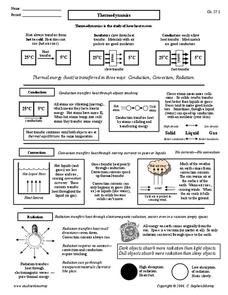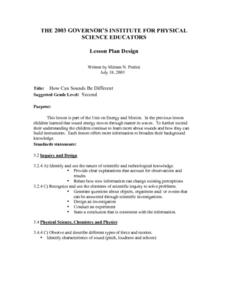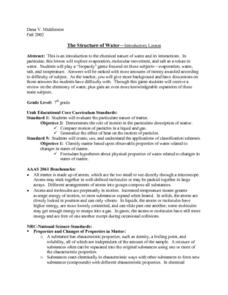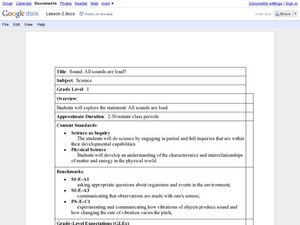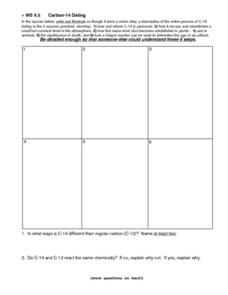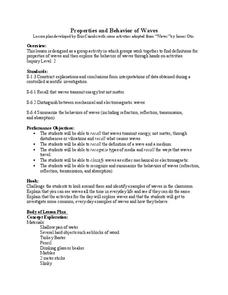Curated OER
Thermodynamics
In this thermodynamics worksheet, students learn about insulators and conductors. Students compare the three ways thermal energy is transferred: conduction, convection, and radiation. This worksheet has 22 matching, 1 multiple choice, 3...
Curated OER
How Can Sounds Be Different
Second graders explore energy and motion. They investigate how sound energy moves in waves. Students explore how sounds are varied and how the instruments that make those sounds are built. They observe sounds being produced and predict...
Curated OER
The Chemical Nature of Water
Seventh graders simulate a Jeopardy game to examine the chemical nature of water. Among the topics featured are evaporation, water, salt, and temperature. finally, as review, 7th graders answer a battery of questions presented by the...
Curated OER
Gravity (Newton's Laws of Motion): A Weighty Subject
Students identify Newton's Laws of Motion. They students explore Newton's Laws of Motion and apply the second law with a classroom activity. The videos will provide visual examples of the effects of gravity while riding on a roller coaster.
Curated OER
Representing Text Story Web: Pretest
In this story web worksheet, students answer multiple choice questions about how to make and use a story web. Students complete 10 questions total.
Curated OER
Sound: Are All Sounds Loud?
First graders explore physics by utilizing education software. In this sound properties lesson, 1st graders discuss the different sounds associated with different materials and perform an object dropping experiment in class. Students...
Curated OER
Carbon-14 Dating
In this carbon dating instructional activity, students write and illustrate a comic strip describing the entire process of C-14 dating. Then students complete 6 short answer and 2 fill in the blank questions.
Curated OER
Let the Sunshine in
Students collect and analyze data to study wavelengths of visible light. They cover Styrofoam cups with three different colors of sun filtering products and shine a lamp directly on the cups. They determine the most effective filtering...
Curated OER
Electrical Energy
Students conduct an experiment to find out how well different wires radiate heat when voltage is applied across the wire. They use the results of their experiments to consider how the gauge of the wire and the type of wire affect the...
Curated OER
Tune Up Your Ears!
Students discuss meaning of pitch, listen for different sounds in classroom, hallway, and outdoors, and listen to sounds played on piano and on computer to determine high or low pitch.
Curated OER
Energy Source
Sixth graders work in groups. They are given one type of energy to research. Students look through the different magazines or newspapers to identify pictures that show their type of energy. Students glue their pictures to the...
Curated OER
Which Wrap Is Wrapped Right?
Students investigate the integrity and strength of different types of food wraps. They test the wraps and create a graphic organizer for the data. Once it is organized then a lab report can be written. The lesson contains background...
Curated OER
Magnetic Attraction
Second graders create a hypothesis on what objects will attract to magnets. In this magnets lesson plan, 2nd graders use a computer program to create a hypothesis as to what will attract or unattract magnets. For an extension, they test...
Curated OER
Properties and Behavior of Waves
Students explore the different properties of waves. In this physics activity, students differentiate mechanical and electromagnetic waves. They explore each lab station and write their observation about the wave behavior they see.


